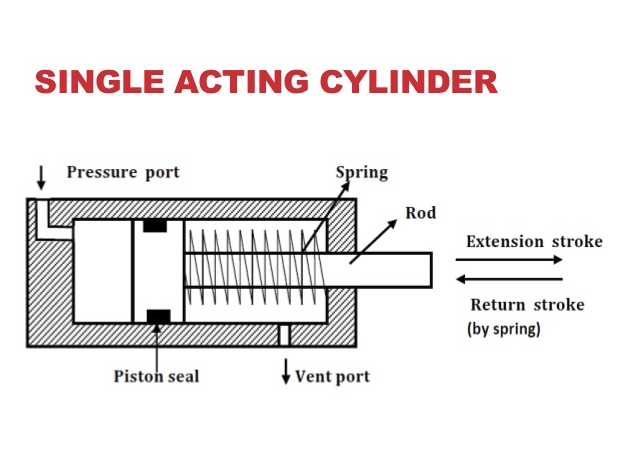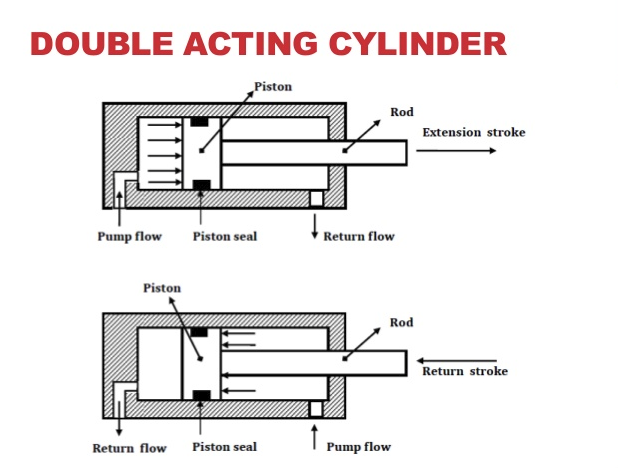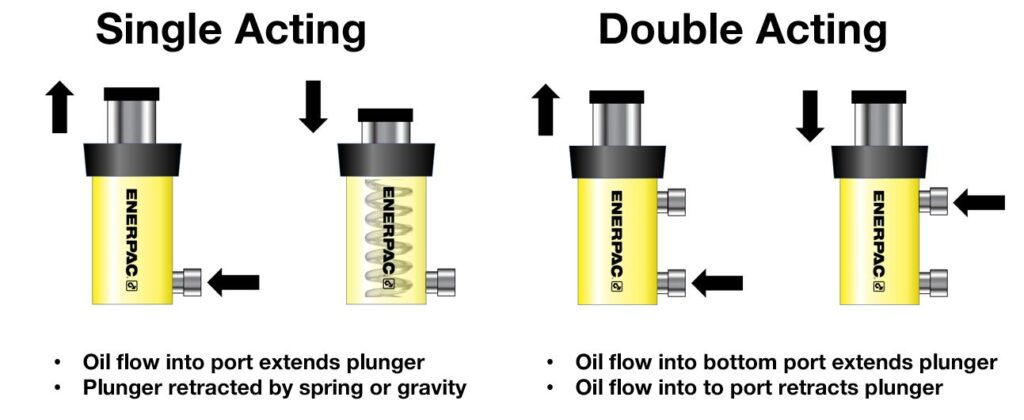Hydraulic cylinders are fundamental components in a wide range of industrial applications, from construction machinery to manufacturing equipment. They provide linear force through fluid power, converting hydraulic energy into mechanical energy to perform various tasks, such as lifting, pushing, pulling, and pressing. Among the various types of hydraulic cylinders, single-acting and double-acting cylinders are the most common. Understanding the differences between these two types is essential for selecting the right hydraulic cylinder for a specific application. In this article, we will explore the key distinctions between single-acting and double-acting hydraulic cylinders, their working principles, advantages, disadvantages, and typical applications.
A single-acting hydraulic cylinder is designed to provide force in only one direction. It consists of a cylinder barrel, a piston rod, and a piston. Hydraulic fluid is supplied to one side of the piston (usually the bottom side), causing the piston to move and extend the piston rod. The return movement of the piston rod, typically retraction, is achieved either by an external force, such as gravity, a mechanical spring, or the load itself. This means that the hydraulic fluid is only used to perform work in one direction—either pushing or pulling.

The working principle of a single-acting hydraulic cylinder is relatively simple. When pressurized hydraulic fluid enters the cylinder through the inlet port, it forces the piston to move in the desired direction. The force generated by the fluid pressure is proportional to the area of the piston and the pressure of the hydraulic fluid. Once the work is done, the piston rod is retracted by an external force or the weight of the load when the hydraulic pressure is released.
1.Simplicity: Single-acting cylinders have a straightforward design, which makes them easier to manufacture, maintain, and repair.
2.Cost-Effective: Due to their simpler design and fewer components, single-acting cylinders are generally more affordable than double-acting cylinders.
3.Energy Efficiency: Since hydraulic fluid is only required for one direction of movement, these cylinders can be more energy-efficient in certain applications.
4.Compact Design: Single-acting cylinders are typically more compact, making them suitable for applications with space constraints.
1.Limited Motion: Single-acting cylinders can only perform work in one direction, which limits their versatility in certain applications.
2.External Force Requirement: The return movement requires an external force, which may not always be available or reliable.
3.Slower Return Stroke: Depending on the external force, the return stroke of a single-acting cylinder may be slower compared to its extension stroke.
Single-acting hydraulic cylinders are commonly used in applications where force is only required in one direction and where an external force can be utilized for retraction. Some typical applications include:
1.Lifting Equipment: Single-acting cylinders are often used in hydraulic jacks, scissor lifts, and hoists, where the lifting force is provided by the cylinder and gravity allows for the return stroke.
2.Dump Trucks: In dump trucks, single-acting cylinders are used to lift the bed for unloading, with gravity providing the force to lower the bed back down.
3.Press Machines: Single-acting cylinders are utilized in hydraulic press machines for tasks like pressing, punching, and forming.
A double-acting hydraulic cylinder, as the name suggests, is capable of providing force in both directions—extending and retracting. It consists of a cylinder barrel, a piston rod, a piston, and two ports for hydraulic fluid—one on each side of the piston. Hydraulic fluid is alternately supplied to each side of the piston, allowing it to move the piston rod back and forth.

The working principle of a double-acting hydraulic cylinder is based on the controlled flow of hydraulic fluid to both sides of the piston. When pressurized fluid is introduced into the extension side of the cylinder, it pushes the piston, causing the piston rod to extend. To retract the piston rod, the fluid is directed to the opposite side of the piston, pushing it in the reverse direction. The ability to apply hydraulic force in both directions allows for more precise and controlled movement.
1.Bidirectional Force: Double-acting cylinders provide force in both directions, making them highly versatile for a wide range of applications.
2.Precise Control: The ability to control the movement of the piston in both directions allows for greater precision in positioning and motion control.
3.Faster Operation: Double-acting cylinders typically offer faster operation since hydraulic pressure is used for both extension and retraction, reducing cycle times.
4.No External Force Needed: Unlike single-acting cylinders, double-acting cylinders do not require an external force for the return stroke, which can be beneficial in applications where such a force is unavailable.
1.Complexity: Double-acting cylinders have a more complex design with additional components, making them more challenging to manufacture, maintain, and repair.
2.Higher Cost: Due to their complexity and additional components, double-acting cylinders are generally more expensive than single-acting cylinders.
3.Increased Energy Consumption: Since hydraulic fluid is required for both extension and retraction, double-acting cylinders may consume more energy compared to single-acting cylinders.
Double-acting hydraulic cylinders are used in applications where precise control, bidirectional force, and speed are essential. Some common applications include:
1.Industrial Automation: Double-acting cylinders are widely used in industrial automation systems, such as robotic arms, conveyor systems, and assembly lines, where precise and repeatable motion is required.
2.Construction Machinery: In construction equipment like excavators, backhoes, and bulldozers, double-acting cylinders are used to control the movement of various components, such as booms, arms, and buckets.
3.Material Handling: Double-acting cylinders are employed in forklifts, cranes, and other material handling equipment to provide the necessary force for lifting, lowering, and positioning loads.
4.Marine Applications: In the marine industry, double-acting cylinders are used in steering systems, winches, and other hydraulic-powered mechanisms that require bidirectional control.
1.Direction of Force: The most significant difference between single-acting and double-acting cylinders is the direction of force. Single-acting cylinders provide force in only one direction, while double-acting cylinders can provide force in both directions.
2.Complexity and Cost: Single-acting cylinders have a simpler design and are generally more cost-effective, whereas double-acting cylinders are more complex and typically more expensive.
3.Energy Efficiency: Single-acting cylinders can be more energy-efficient in applications where force is only needed in one direction, while double-acting cylinders may consume more energy due to the need for hydraulic fluid in both directions.
4.Control and Speed: Double-acting cylinders offer more precise control and faster operation, making them suitable for applications that require high-speed and accurate positioning.
5.External Force Requirement: Single-acting cylinders rely on an external force for the return stroke, while double-acting cylinders do not require any external force, making them more versatile in a broader range of applications.

Choosing between a single-acting and a double-acting hydraulic cylinder depends on the specific requirements of the application. Single-acting cylinders are ideal for situations where force is only needed in one direction, and an external force can be used for retraction. They are simpler, more cost-effective, and suitable for lifting, pressing, and other similar tasks.
On the other hand, double-acting cylinders are better suited for applications that require bidirectional force, precise control, and faster operation. While they are more complex and expensive, their versatility and performance make them indispensable in industrial automation, construction machinery, material handling, and many other fields.
Understanding the differences between these two types of hydraulic cylinders will help you make an informed decision when selecting the right cylinder for your application, ensuring optimal performance, efficiency, and cost-effectiveness.